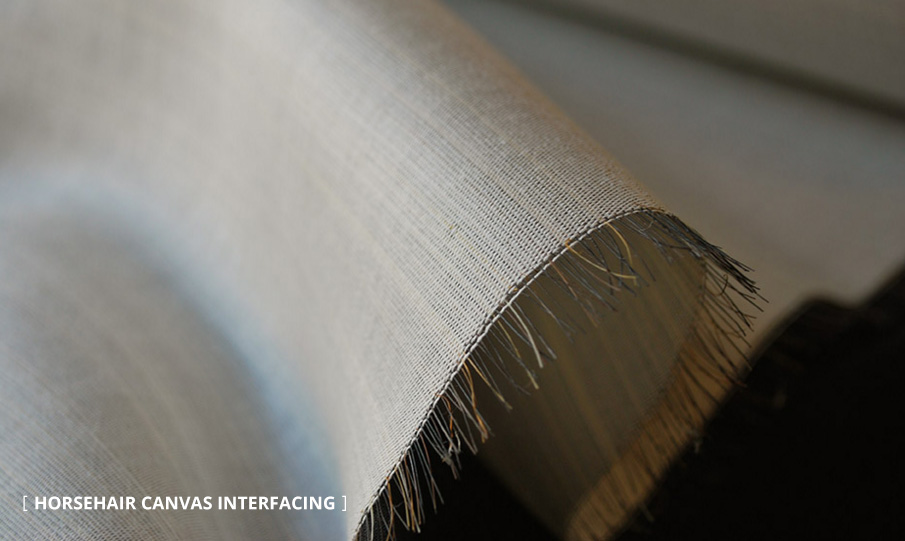Part 1: Tools of the Trade | Part 2: Pattern Hacking | Part 3: Interfacing | | Part 4: Fastenings
It’s what’s on the inside that counts…
It’s an old adage that it is what is on the inside that counts, and when it comes to constructing a professional garment, it makes a huge difference to collars, cuffs, waistbands and more…
There are three main types of interfacing:
1. Non – woven: made from fibres all pressed together it creates a fabric like felt or paper. It has no grain, so avoid wastage by cutting any which way. It offers a firm support and no flexibility. It also tends to be the cheapest option.
2. Woven: have a grain and should be treated like other woven fabrics. They are more flexible and tend to be softer.
3. Knit: are the most flexible of interfacing, they have two-way stretch and are used to add support without compromising the stretch of a fabric.
You can buy these as fusible (with glue you can iron-on) or sew-in; they come in various weights. Just remember to always buy the weight that matches your fabric i.e. if you are sewing with a light cotton pick a light interfacing, if you are sewing with heavy wool pick a heavy interfacing. Vilene is the biggest company that produces these fabrics and they tend to be the best quality – click here to view our range of Vilene interfacings.
With fusible interfacing make sure that you place the shiny side down on the wrong side of your fabric and iron. Try not to get glue on your iron as it ends up a big sticky mess that will transfer to everything you try to iron afterwards. Keep it clean with an iron cleaner stick. Or if you’re lucky and have a lot of space have a spare ironing board cover and iron just for these sticky jobs.
To take your garment to the next level, why not try some more traditional, high-end interfacings?
Silk organza: Used on lightweight fabrics to add body or “puff” so try it in sleeves for extra puff or as petticoats for full skirts (not as scratchy as net or tulle!) but it can also be used in collars and cuffs for lightweight support – think blouse not dinner shirt.
Top tip! Save your silk organza scraps and use them as ironing cloths. You can see through them and it will help reduce shine or burns caused by your iron on delicate fabrics.
Power net/tricot: A soft knit fabric that can offer some support to the wearer as well as the garment. Embrace your inner couturier and try inserting a corselette [1] into a wiggle dress to smooth those lumps and bumps! If you are making a vintage dress why not try cotton bobbinette like the Dior “New Look” dresses?
Horsehair: Not actually horsehair anymore, otherwise known as canvas (sometimes mixed with goats hair). This is usually used in tailoring for jackets and waistbands. Not ready for Saville Row yet? Try pad stitching [2] a waistband on a skirt or trousers and notice the difference!
Taffeta: Beautiful for silks or medium cottons. The stiffness of this fabric makes it great for interfacing.
Petersham ribbon: Do not confuse this with grosgrain. Petersham ribbon is stiff and ridged like grosgrain but the edge of the ribbon is bumpy and it can bend a bit like bias binding (whereas grosgrain can’t). This is excellent to use as waistbanding [3] but also for waist-stays and supporting a neckline on a strapless dress.
Confused about what to use? Then when in doubt use another layer of the fabric you are using!
![]()
[1] A corset like structure usually with boning that adds support to the dress and the wearer that is attached to the dress.
[2] Pad stitching is a form of stitching that attaches the interfacing to the main fabric. Through a series of long stitches you can help mould and shape the fabric. Time consuming but gives beautiful results.
[3] Instead of a facing on your waistband try using petersham instead.
![]()








 We’re thrilled to announce that we’ve partnered with Tree Nation, the platform to reforest the world & fight climate change! Home to over 90 planting projects in 33 countries, Tree Nation is a non-profit organisation that helps people & companies offset their CO2 emissions.
We’re thrilled to announce that we’ve partnered with Tree Nation, the platform to reforest the world & fight climate change! Home to over 90 planting projects in 33 countries, Tree Nation is a non-profit organisation that helps people & companies offset their CO2 emissions.